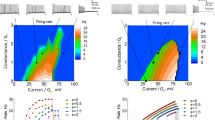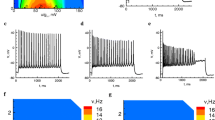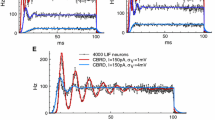Abstract
A wide diversity of models have been proposed to account for the spiking response of central neurons, from the integrate-and-fire (IF) model and its quadratic and exponential variants, to multiple-variable models such as the Izhikevich (IZ) model and the well-known Hodgkin–Huxley (HH) type models. Such models can capture different aspects of the spiking response of neurons, but there is few objective comparison of their performance. In this article, we provide such a comparison in the context of well-defined stimulation protocols, including, for each cell, DC stimulation, and a series of excitatory conductance injections, arising in the presence of synaptic background activity. We use the dynamic-clamp technique to characterize the response of regular-spiking neurons from guinea-pig visual cortex by computing families of post-stimulus time histograms (PSTH), for different stimulus intensities, and for two different background activities (low- and high-conductance states). The data obtained are then used to fit different classes of models such as the IF, IZ, or HH types, which are constrained by the whole data set. This analysis shows that HH models are generally more accurate to fit the series of experimental PSTH, but their performance is almost equaled by much simpler models, such as the exponential or pulse-based IF models. Similar conclusions were also reached by performing partial fitting of the data, and examining the ability of different models to predict responses that were not used for the fitting. Although such results must be qualified by using more sophisticated stimulation protocols, they suggest that nonlinear IF models can capture surprisingly well the response of cortical regular-spiking neurons and appear as useful candidates for network simulations with conductance-based synaptic interactions.
Similar content being viewed by others
References
Achard P, De Schutter E (2006) Parameter landscape for a complex neuron model. PLoS Comput Biol 2: 794–804
Badel L, Lefort S, Brette R, Petersen CH, Gerstner W, Richardson MJE (2008) I–V curves are reliable predictors of naturalistic pyramidal-neuron voltage traces. J Neurophysiol 99: 656–666
Brette R, Gerstner W (2005) exponential integrate-and-fire model as an effective description of neuronal activity. J Neurophysiol 94: 3637–3642
Brette R, Piwkowska Z, Monier C, Rudolph-Lilith M, Fournier J, Levy M, Frégnac Y, Bal T, Destexhe A (2008) intracellular recordings using a real-time computational model of the electrode. Neuron 59: 379–391
Clopath C, Jolivet R, Rauch A, Lüscher HR, Gerstner W (2007) Predicting neuronal activity with simple models of the threshold type: Adaptive Exponential Integrate-and-Fire model with two compartments. Neurocomputing 70: 1668–1673
Destexhe A (1997) Conductance-based integrate-and-fire models. Neural Comput 9: 503–514
Destexhe A, Mainen ZF, Sejnowski TJ (1994) An efficient method for computing synaptic conductances based on a kinetic model of receptor binding. Neural Comput 6: 14–18
Destexhe A, Rudolph M, Fellous JM, Sejnowski TJ (2001) Fluctuating synaptic conductances recreate in-vivo-like activity in neocortical neurons. Neuroscience 107: 13–24
Destexhe A, Rudolph M, Paré D (2003) The high-conductance state of neocortical neurons in vivo. Nat Rev Neurosci 4: 739–751
Druckmann S, Banitt Y, Gidon A, Schürmann F, Markram H, Segev I (2007) A novel multiple objective optimization framework for constraining conductance-based neuron models by experimental data. Frontiers Neurosci 1: 7–18
Ermentrout GB (1996) Type 1 membranes, phase resetting curves, and synchrony. Neural Comput 8: 979–1001
Fitzhugh R (1961) Impulses and physiological states in models of nerve membrane. Biophys J 1: 445–466
Fourcaud-Trocmé N, Hansel D, van Vreeswijk C, Brunel N (2003) How spike generation mechanisms determine the neuronal response to fluctuating inputs. J Neurosci 23: 11628–11640
Goaillard JM, Taylor AL, Schulz DJ, Marder E (2009) Functional consequences of animal-to-animal variation in circuit parameters. Nature Neurosci 12: 1424–1430
Herrmann A, Gerstner W (2001) Noise and the PSTH response to current transients: I. General theory and application to the integrate-and-fire neuron. J Comput Neurosci 11: 135–151
Herrmann A, Gerstner W (2002) Noise and the PSTH response to current transients: II. Integrate-and-fire model with slow recovery and application to motoneuron data. J Comput Neurosci 12: 83–95
Hines ML, Carnevale NT (1997) The NEURON simulation environment. Neural Comput 9: 1179–1209
Hodgkin AL, Huxley AF (1952) A quantitative description of membrane current and its application to conduction and excitation in nerve. J Physiol 117: 500–544
Izhikevich EM (2003) Simple model of spiking neurons. IEEE Trans Neural Networks 14: 1569–1572
Izhikevich EM (2004) Which model to use for cortical spiking neurons?. IEEE Trans Neural Networks 15: 1063–1070
Jolivet R, Lewis TJ, Gerstner W (2004) Generalized integrate-and-fire models of neuronal activity approximate spike trains of a detailed model to a high degree of accuracy. J Neurophysiol 92: 959–976
Jolivet R, Rauch A, Lüscher HR, Gerstner W (2006) Predicting spike timing of neocortical pyramidal neurons by simple threshold models. J Comput Neurosci 21: 35–49
Jolivet R, Schürmann F, Berger TK, Naud R, Gerstner W, Roth A (2008) The quantitative single-neuron modeling competition. Biol Cybern 99: 417–426
Kobayashi R, Tsubo Y, Shinomoto S (2009) Made-to-order spiking neuron model equipped with a multi-timescale adaptive threshold. Frontiers Comput Neurosci 3: 9
Lapicque L (1907) Recherches quantitatives sur l’excitation electrique des nerfs traitée comme une polarisation. J Physiol Pathol Gen 9: 620–635
Latham PE, Richmond BJ, Nelson PG, Nirenberg S (2000) Intrinsic dynamics in neuronal networks. I. Theory. J Neurophysiol 83: 808–827
Le Franc Y, Foutry B, Nagy F, Le Masson G. (2001) Nociceptive signal transfer through the dorsal horn network: hybrid and dynamic clamp approaches using a real-time implementation of the Neuron simulation environment. Soc Neurosci Abstracts 27: 927.18
Le Masson G, Maex R. Introduction to equation solving and parameter fitting. In: De Schutter E, editor. Computational neuroscience: realistic modeling for experimentalists. CRC Press, London
Morris C, Lecar H (1981) Voltage oscillations in the barnacle giant muscle fiber. Biophys J 35: 193–213
Nagumo JS, Arimoto S, Yoshizawa S (1962) An active pulse transmission line simulating nerve axon. Proc IRE 50: 2061–2070
Piwkowska Z, Pospischil M, Brette R, Sliwa J, Rudolph-Lilith M, Bal T, Destexhe A (2008) Characterizing synaptic conductance fluctuations in cortical neurons and their influence on spike generation. J Neurosci Methods 169: 302–322
Pospischil M, Toledo-Rodriguez M, Monier C, Piwkowska Z, Bal T, Frégnac Y, Markram H, Destexhe A (2008) Minimal Hodgkin-Huxley type models for different classes of cortical and thalamic neurons. Biol Cybern 99: 427–441
Press WH, Flannery BP, Teukolsky SA (1992) Numerical Recipes in C: The Art of Scientific Computing, 2nd edn. Cambridge University Press, Cambridge
Robinson HP, Kawai N (1993) Injection of digitally synthesized synaptic conductance transients to measure the integrative properties of neurons. J Neurosci Methods 49: 157–165
Sadoc G, Le Masson G, Foutry B, Le Franc Y, Piwkowska Z, Destexhe A, Bal T (2009) Recreating in vivo–like activity and investigating the signal transfer capabilities of neurons: dynamic-clamp applications using real-time NEURON. In: Destexhe A, Bal T (eds) Dynamic-clamp: from principles to applications. Springer, New York
Sharp AA, O’Neil MB, Abbott LF, Marder E (1993) Dynamic-clamp: computer-generated conductances in real neurons. J Neurophysiol 69: 992–995
Traub RD, Miles R (1991) Neuronal networks of the hippocampus. Cambridge University Press, Cambridge
Van Geit W, De Schutter E, Achard P (2008) Automated neuron model optimization techniques: a review. Biol Cybern 99: 241–251
Vanier MC, Bower JM (1999) A comparative survey of automated parameter-search methods for compartmental neural models. J Computational Neurosci 7: 149–171
Weaver CM, Wearne SL (2006) The role of action potential shape and parameter constraints in optimization of compartment models. Neurocomputing 69: 1053–1057
Wolfart J, Debay D, Le Masson G, Destexhe A, Bal T (2005) Synaptic background activity controls spike transfer from thalamus to cortex. Nature Neurosci 8: 1760–1767
Yamada WM, Koch C, Adams PR (1989) Multiple channels and calcium dynamics. In: Koch C, Segev I (eds) Methods in neuronal modeling. MIT press, Cambridge
Author information
Authors and Affiliations
Corresponding author
Rights and permissions
About this article
Cite this article
Pospischil, M., Piwkowska, Z., Bal, T. et al. Comparison of different neuron models to conductance-based post-stimulus time histograms obtained in cortical pyramidal cells using dynamic-clamp in vitro. Biol Cybern 105, 167–180 (2011). https://doi.org/10.1007/s00422-011-0458-2
Received:
Accepted:
Published:
Issue Date:
DOI: https://doi.org/10.1007/s00422-011-0458-2




